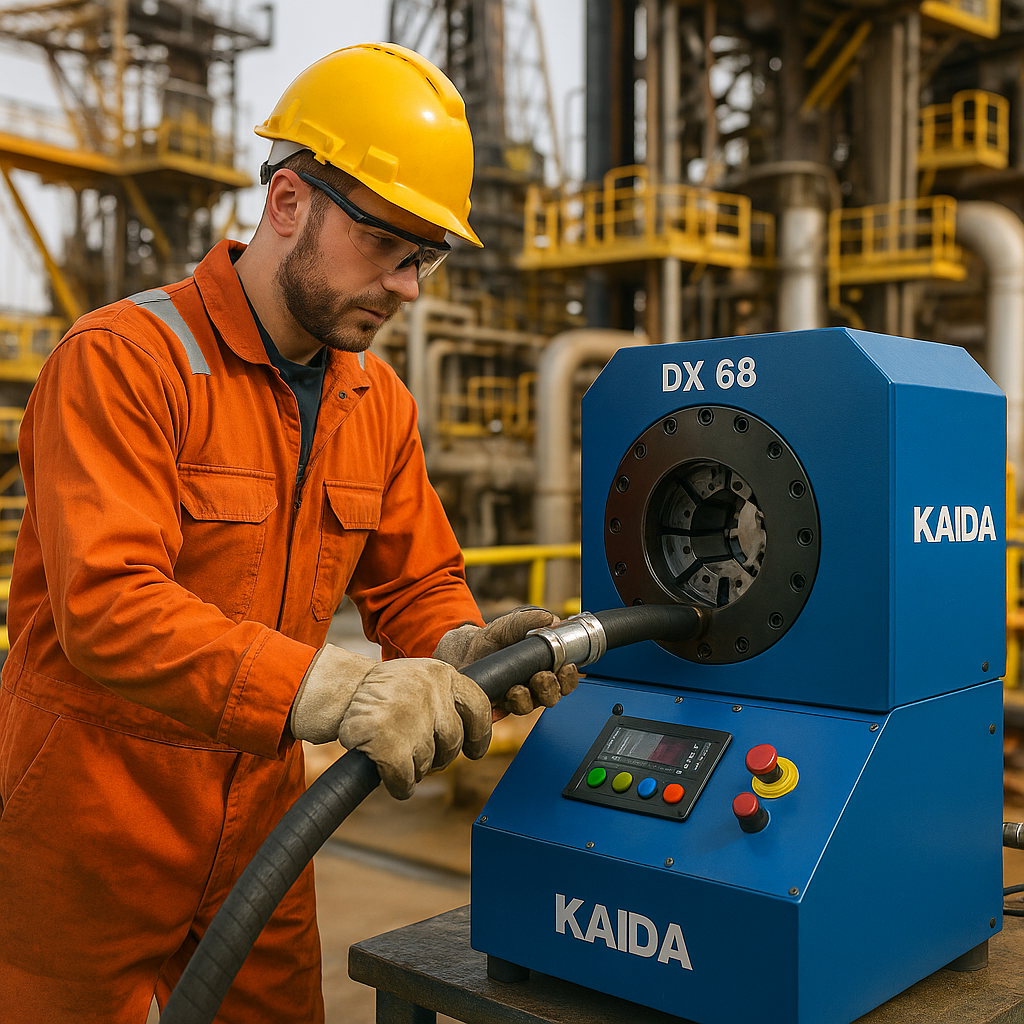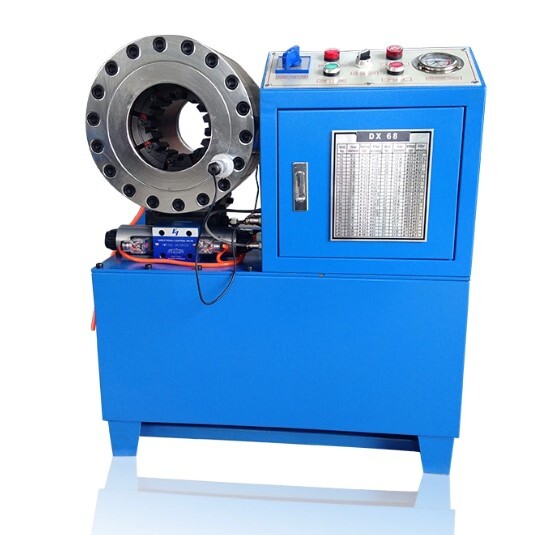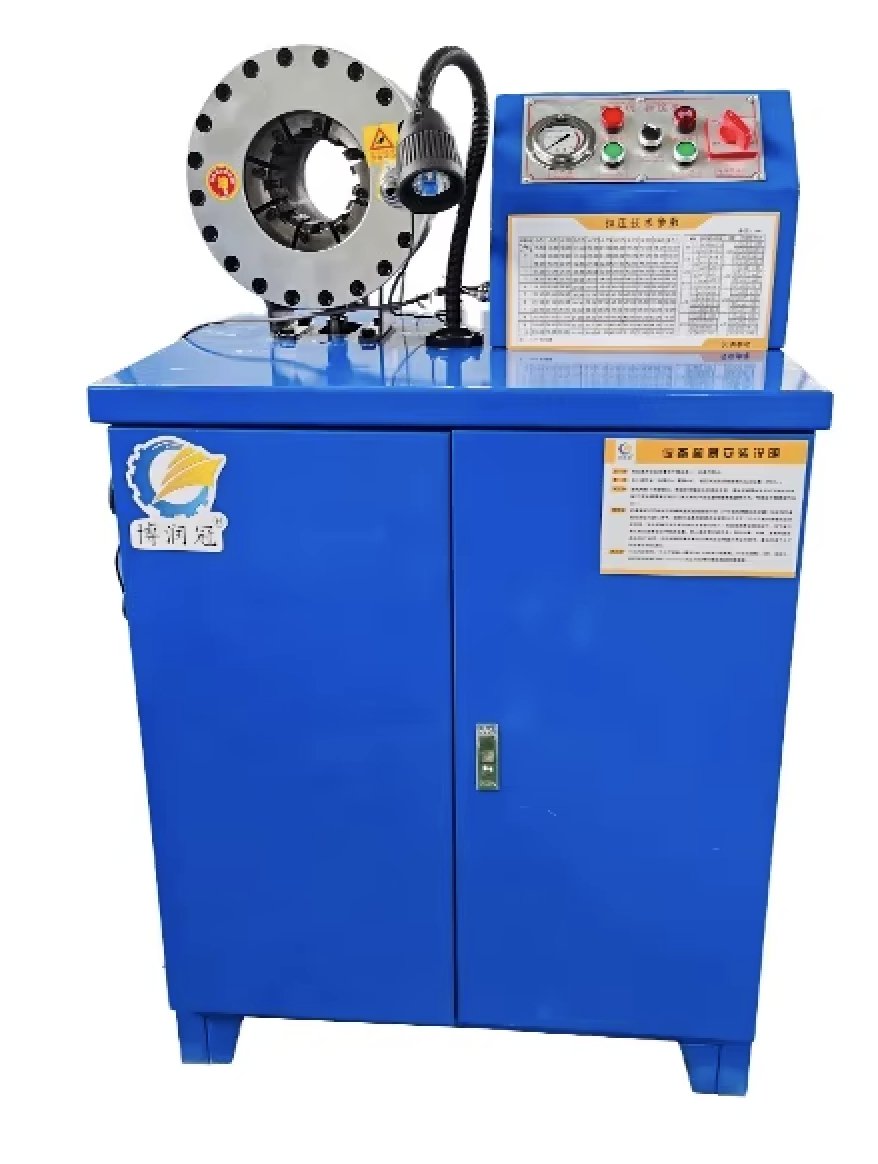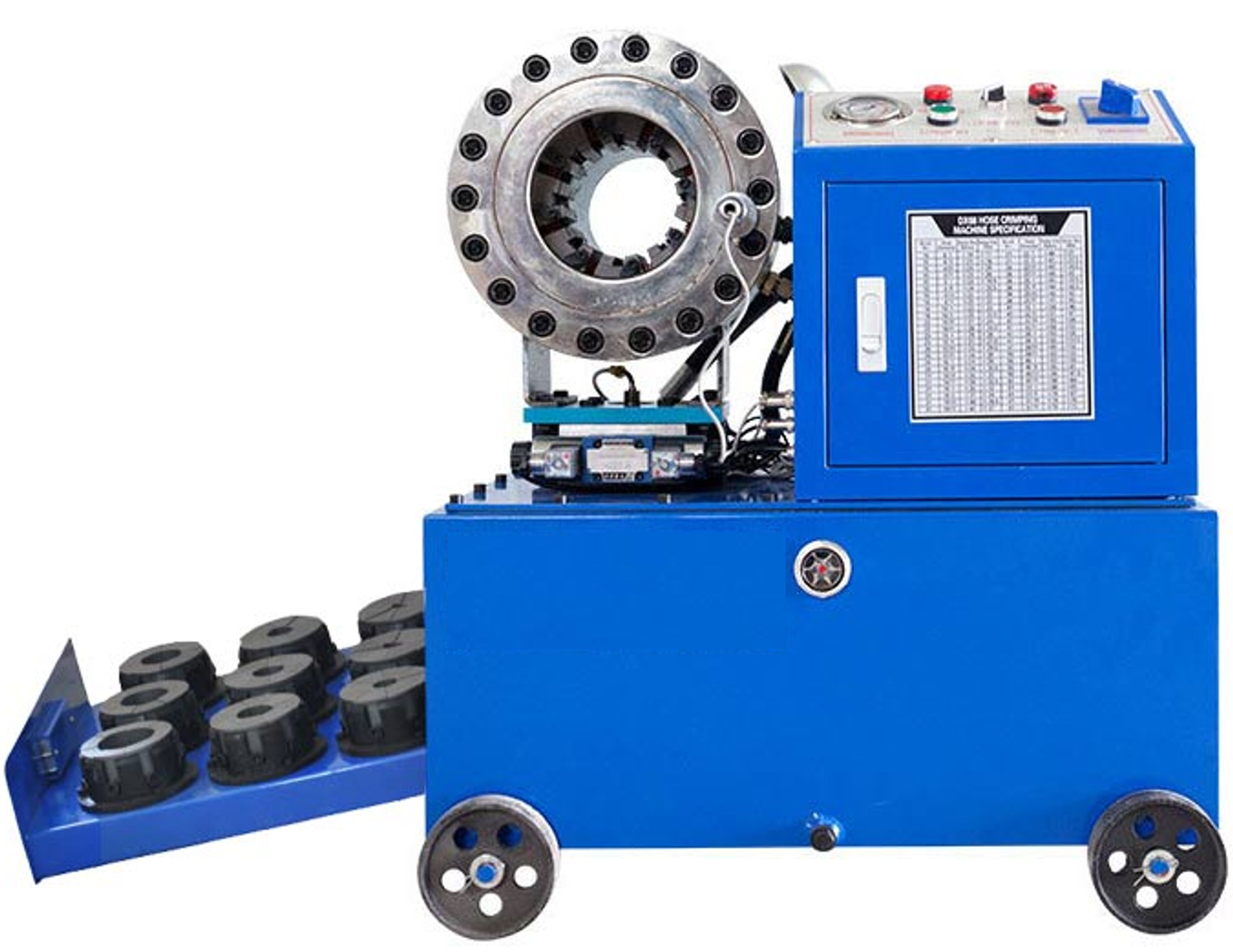Hydraulic Hose Crimping Machines: Types, Applications, and Best Practices
Introduction
Hydraulic systems power some of the most important equipment used in construction, mining, manufacturing, automotive, and oil & gas industries. At the heart of these systems are hydraulic hoses, which carry pressurized fluids to transfer energy. For these hoses to function safely and reliably, they must be assembled with secure, leak-proof fittings and this is where hydraulic hose crimping machines come in.
A hydraulic hose crimping machine ensures that fittings are tightly attached to the hose by compressing them under high pressure, creating a durable seal that can withstand extreme operating conditions. Without proper crimping, hoses are prone to leaks, blowouts, or early failure, risks that can cause costly downtime, accidents, or damage to equipment.
This guide will walk you through the types of crimping machines, their applications across industries, and best practices to follow for safety, efficiency, and long equipment life.
An oil and gas engineer secures a high-pressure hydraulic hose using the Kaida DX 68 crimping machine, ensuring leak-free connections for rigs and refineries.
What is a Hydraulic Hose Crimping Machine?
A hydraulic hose crimping machine is a specialized tool used to attach fittings securely onto hydraulic hoses. The machine compresses a metal sleeve, called a ferrule, around the hose and fitting, ensuring a tight seal that can handle the system’s operating pressure.
- Core function: Prevents leaks and ensures pressure integrity in hydraulic circuits.
- How it works: The hose is placed with a fitting inside the machine’s crimping head. Using mechanical, hydraulic, or pneumatic force, the ferrule is compressed evenly around the hose.
- Why it matters: Proper crimping guarantees safety, reliability, and longer service life for hydraulic systems.
Whether in a factory or a field repair scenario, crimping machines are essential to keep hydraulic-powered equipment functioning efficiently.
 Hydraulic Hose Crimping Machine 220V DX68 KAIDA
Hydraulic Hose Crimping Machine 220V DX68 KAIDA
Types of Hydraulic Hose Crimping Machines
Manual Crimping Machines
- Operated by hand, usually with a lever.
- Lightweight and portable — ideal for on-site or emergency repairs.
- Limited capacity, suitable for small-diameter hoses and light-duty work.
Electric Crimping Machines
- Powered by electricity for faster, consistent results.
- Common in workshops and small-scale industries.
- Can handle medium hose sizes with better accuracy than manual models.
Hydraulic Crimping Machines
- Heavy-duty equipment powered by hydraulic pumps.
- Suitable for large hoses and industrial applications where high crimping force is required.
- Stationary models are typically used in factories or service centers.
Pneumatic / Automatic Crimping Machines
- Air-powered or fully automated, designed for high-volume production.
- Offers precision, speed, and efficiency with minimal operator effort.
- Best for manufacturers and large repair facilities that handle thousands of hoses monthly.
 Hydraulic Hose Crimping 4KVA /220-415V HP51 KAIDA
Hydraulic Hose Crimping 4KVA /220-415V HP51 KAIDA
Applications of Hydraulic Hose Crimping Machines
Hydraulic hose crimping machines are indispensable across multiple industries where fluid power is the backbone of operations. Their ability to deliver safe, leak-proof hose assemblies makes them crucial in both production and maintenance environments.
Automotive Industry
- Used for brake lines, power steering hoses, and AC systems.
- Ensures reliability in vehicles where hydraulic pressure is essential for safety and performance.
- Auto repair shops often rely on compact crimping machines for quick replacements.
Construction & Mining
- Heavy machinery such as excavators, bulldozers, loaders, and cranes depend on high-pressure hoses.
- Field failures can halt projects, so on-site crimping machines are vital for quick repairs.
- Prevents costly downtime in large construction and mining projects.
Oil & Gas Sector
- Used in offshore rigs, pipelines, and hydraulic lifting systems.
- Critical for high-pressure environments where hose failure could cause accidents or environmental hazards.
- Portable crimpers are often deployed for field maintenance in remote oilfields.
Manufacturing & Maintenance Workshops
- Factories with hydraulic presses, injection molding machines, or assembly lines need consistent hose integrity.
- Workshops use stationary hydraulic or electric crimpers to prepare hoses in bulk for equipment servicing.
Agriculture
- Tractors, harvesters, irrigation pumps, and other farm machinery all require reliable hydraulic systems.
- Mobile crimping machines are valuable for farmers or service providers handling repairs in rural locations.
 Hydraulic Hose Crimping Machine 800W DF68 KAIDA
Hydraulic Hose Crimping Machine 800W DF68 KAIDA
Key Features to Consider When Choosing a Crimping Machine
Selecting the right hydraulic hose crimping machine depends on the nature of your work, the size of hoses you handle, and how frequently you use the machine. The following factors should guide your decision:
Hose Size & Crimping Capacity
- Check the maximum hose diameter the machine can handle.
- Manual machines may be limited to small hoses, while industrial hydraulic models can manage large, heavy-duty hoses.
Power Source
- Manual: Best for portability, emergencies, and field repairs.
- Electric: Suitable for workshops that require speed and consistency.
- Hydraulic or Pneumatic: Ideal for high-volume, heavy-duty crimping in factories or industrial sites.
Portability vs. Stationary Use
- Portable units are lightweight and field-friendly for on-site repairs.
- Stationary units are larger, more powerful, and better suited for service centers or factories.
Automation Level & Precision
- Basic models require manual adjustment and operator skill.
- Automatic and semi-automatic crimpers improve precision, reduce operator error, and speed up production.
Durability & Build Quality
- Machines should be made from robust, wear-resistant materials to withstand continuous crimping.
- A sturdy build reduces breakdowns and extends machine life.
Ease of Use & Calibration
- Look for user-friendly controls, clear die charts, and straightforward calibration systems.
- This reduces operator training time and ensures consistent crimp quality.
After-Sales Support & Spare Parts Availability
- Access to replacement dies, seals, and spare parts in Nigeria is crucial.
- Reliable warranty and support from distributors like Epoxy Oilserv, GZ Industrial Supplies, or Tikweld Welding Supplies can minimize downtime.
Best Practices for Using Hydraulic Hose Crimping Machines
A crimping machine is only as effective as the operator using it. Following best practices ensures safety, accuracy, and longer machine life. Here are key guidelines:
Train Operators Properly
- Every operator should be trained on the specific model of crimping machine being used.
- Training reduces the risk of accidents and ensures consistent, high-quality crimps.
Follow Manufacturer’s Die Charts
- Each hose and fitting combination requires a specific die size and crimping setting.
- Using the wrong die can lead to leaks, hose blowouts, or damaged fittings.
Inspect Hoses and Fittings Before Crimping
- Always check for cracks, abrasions, or contamination on the hose.
- Ensure fittings are clean, undamaged, and compatible with the hose type.
Perform a Test Crimp First
- When using a new setup, always conduct a trial crimp on a sample hose.
- Measure the crimp diameter with a caliper to confirm it matches specifications before proceeding with bulk production.
Maintain a Clean Work Area
- Dirt and debris can cause faulty crimps and damage the machine.
- Keep dies, fittings, and the crimping head free of contaminants.
Conduct Post-Crimp Inspections
- After crimping, inspect the hose visually for cracks, uneven compression, or deformation.
- Perform a pressure test when possible to confirm the hose can withstand operating conditions.
Prioritize Operator Safety
- Wear protective gloves and safety glasses when handling high-pressure hoses.
- Never bypass machine safety guards or override built-in controls.
Common Mistakes to Avoid in Hose Crimping
Even with the best machines and training, errors during hose crimping can compromise safety and performance. Avoiding these mistakes is key to producing durable and reliable hydraulic assemblies.
Using the Wrong Die Size
- Selecting a die that’s too large results in under-crimping, causing leaks and loose fittings.
- A die that’s too small leads to over-crimping, which can crush the hose or weaken the fitting.
Ignoring Pressure Ratings
- Not matching the hose and fitting to the required working pressure can lead to catastrophic hose failures under load.
- Always check compatibility with the system’s pressure range.
Over- or Under-Crimping
- Over-crimping causes structural damage and restricts fluid flow.
- Under-crimping leaves gaps that allow leaks and reduce service life.
Skipping Hose & Fitting Inspection
- Crimping worn-out or contaminated hoses and fittings can create unsafe assemblies.
- Dirt, oil, or rust left inside the hose can weaken the seal.
Poor Hose Preparation
- Failing to cut the hose cleanly or not inserting the fitting fully leads to uneven crimps.
- Always use a proper hose-cutting tool for smooth, square cuts.
Neglecting Post-Crimp Testing
- Many failures occur because hoses weren’t tested after crimping.
- Hydrostatic or pressure testing is essential for critical applications like oil & gas or mining.
Common Mistakes to Avoid in Hose Crimping
Crimping hydraulic hoses requires precision, and even small errors can cause leaks, premature hose failure, or safety hazards. Below are the most frequent mistakes technicians make—and how to avoid them:
Choosing the Wrong Die or Crimping Setting
- Using an incorrect die size or crimping diameter often results in poor sealing.
- Impact: Either the fitting slips off (under-crimp) or the hose gets crushed (over-crimp).
- Solution: Always consult the manufacturer’s die chart before crimping.
Ignoring Hose & Fitting Compatibility
- Not all hoses and fittings are designed to work together. Mixing brands or types can cause mismatched tolerances.
- Impact: Weak joints that fail under pressure.
- Solution: Use manufacturer-approved hose and fitting combinations only.
Inadequate Hose Preparation
- Improper cutting (angled or frayed ends) or failing to clean the hose interior before crimping.
- Impact: Dirt, steel wire fragments, or uneven cuts weaken the seal.
- Solution: Use a dedicated hose-cutting saw for clean cuts and blow out debris before crimping.
Overlooking Hose Insertion Depth
- If the fitting is not inserted to the correct depth, the crimp will not compress evenly.
- Impact: Loose fittings or partial crimps that fail under load.
- Solution: Mark insertion depth before crimping and verify alignment.
Skipping Post-Crimp Inspection and Testing
- Assuming a crimp is successful without measuring or testing it.
- Impact: Undetected weak crimps lead to sudden failures in the field.
- Solution: Measure crimp diameter with calipers and perform a pressure test when required.
Maintenance Tips for Longer Machine Life
Hydraulic hose crimping machines are heavy-duty tools, but like all precision equipment, they require regular maintenance to stay reliable. Neglecting upkeep not only reduces machine accuracy but can also lead to costly breakdowns. Following these maintenance tips will ensure your crimper delivers consistent, safe results for years:
Clean Dies and Components After Every Use
- Residual grease, dust, or hose fragments can interfere with crimping accuracy.
- Wipe down the dies, crimping head, and work area daily to prevent buildup.
Lubricate Moving Parts Regularly
- Apply recommended lubricants to the machine’s moving components.
- This reduces wear, ensures smoother operation, and extends component lifespan.
Calibrate the Machine Periodically
- Over time, machines can drift out of calibration, affecting crimp accuracy.
- Follow the manufacturer’s schedule for calibration checks and adjust as needed.
Inspect Hydraulic Systems
- For hydraulic-powered crimpers, check oil levels, hoses, and seals.
- Replace any worn-out seals to prevent leaks and maintain stable crimping pressure.
Store in a Clean, Dry Environment
- Moisture, dust, and extreme temperatures can damage sensitive components.
- Always store in a controlled environment when not in use.
Replace Worn Parts Promptly
- Dies, seals, and fittings naturally wear with use.
- Using damaged or worn parts compromises crimp quality and machine safety.
Frequently Asked Questions
What is the difference between manual and electric crimping machines?
- Manual machines are hand-operated, lightweight, and suitable for small hoses and field repairs. Electric machines, on the other hand, use power for faster, more consistent results and are better for workshops with medium-volume needs.
How do I know if a crimp is successful?
- A proper crimp matches the manufacturer’s specified diameter, shows no visible cracks or unevenness, and passes a pressure test without leaks.
Can one machine handle all hose sizes?
- No. Each crimping machine has a specific size range. Large industrial hoses require heavy-duty hydraulic crimpers, while small hoses can be managed with manual or electric models.
How often should I calibrate a crimping machine?
- Most manufacturers recommend regular calibration every few months or after a set number of crimps. High-volume operations should check more frequently.
Where can I buy genuine hydraulic hose crimping machines in Nigeria?
- Reliable suppliers include GZ Industrial Supplies, and Tikweld Welding Supplies, which offer nationwide delivery, spare parts, and after-sales support.
Related Article
MECHANISM OF HYDRAULIC HOSE CRIMPING MACHINE
Conclusion
Hydraulic hose crimping machines are essential tools that ensure safe, leak-proof connections in industries ranging from automotive and agriculture to oil & gas and construction. By understanding the different types of machines, their applications, and best practices, businesses can make smarter investments and improve both safety and efficiency.
Whether you need a manual crimper for field repairs, an electric unit for workshop use, or a heavy-duty hydraulic/automatic crimping machine for large-scale operations, the right choice depends on your workload, hose sizes, and budget. Proper use, regular maintenance, and avoiding common mistakes will further extend the lifespan of both your machine and the hoses it services.
Looking for a reliable crimping machine in Nigeria? Shop genuine hydraulic hose crimping machines today from Epoxy Oilserv, GZ Industrial Supplies, and Tikweld Welding Supplies. Enjoy nationwide delivery, expert guidance, and warranty-backed products to keep your operations running smoothly.
Contact us at 08071993873 or visit tikweld.com for inquiries.












